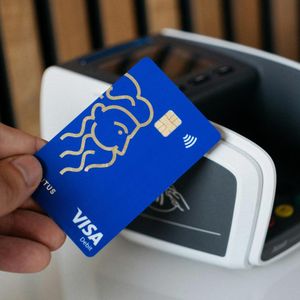Anticipating Fed Rate Cuts: Goldman Sachs Executive Predicts Autumn Shift
8 min read
BitcoinWorld Anticipating Fed Rate Cuts: Goldman Sachs Executive Predicts Autumn Shift The financial world is abuzz with speculation, and for good reason. For anyone invested in the dynamic cryptocurrency market, understanding the Federal Reserve’s next moves is paramount. The potential for Fed rate cuts looms large, signaling a significant shift in monetary policy that could ripple through global markets, including digital assets. A recent statement from a Goldman Sachs executive has added fuel to this anticipation, suggesting that a pivotal moment for interest rates might be just around the corner. Understanding the Fed’s Stance: What Exactly Are Fed Rate Cuts ? At the heart of global finance lies the Federal Reserve, the central bank of the United States. One of its most powerful tools for influencing the economy is the federal funds rate – the target rate for overnight borrowing between banks. When the Fed decides to implement Fed rate cuts , it lowers this benchmark rate, making it cheaper for banks to borrow money. This, in turn, encourages lending to consumers and businesses, stimulates economic activity, and can make riskier assets, like cryptocurrencies, more attractive. Dovish vs. Hawkish: Federal Reserve officials often lean towards either a ‘dovish’ or ‘hawkish’ stance. A dovish stance prioritizes economic growth and employment, often favoring lower interest rates. A hawkish stance, conversely, prioritizes controlling inflation, often through higher rates. The recent comments from FOMC members Waller and Bowman, as noted by Goldman Sachs’ Ashish Shah, suggest a more dovish tilt, indicating a growing willingness to consider easing monetary policy. The Easing Cycle: When the Fed begins to lower rates, it’s often referred to as an ‘easing cycle.’ This period typically aims to inject liquidity into the financial system and support economic expansion. Impact on Borrowing: Lower rates mean cheaper mortgages, car loans, and business credit, encouraging spending and investment. The Inflation Conundrum: Why Does It Matter for Potential Fed Rate Cuts ? Inflation, the persistent rise in the price of goods and services, is a primary concern for the Federal Reserve. Their mandate includes maintaining price stability. For months, the Fed has been monitoring inflation closely, trying to bring it down from multi-decade highs without triggering a recession. Ashish Shah highlighted that most FOMC members agree on the need to monitor inflation trends throughout the summer. This suggests a cautious, data-dependent approach before committing to Fed rate cuts . One key aspect mentioned by Shah is the potential for inflationary pressure caused by tariffs to be temporary. Tariffs, or taxes on imported goods, can increase the cost of those goods, contributing to inflation. If the Fed believes this particular source of inflation is fleeting and not indicative of broader, more persistent inflationary trends, it provides more leeway for them to consider rate adjustments. The distinction between temporary and sticky inflation is critical for the Fed’s decision-making process. Goldman Sachs’ Perspective: A Glimpse into Market Expectations for Fed Rate Cuts When an executive from a financial powerhouse like Goldman Sachs speaks, the market listens. Ashish Shah, as Chief Investment Officer of Goldman Sachs Asset Management’s Public Investment Division, holds a significant position, overseeing vast portfolios and having a deep understanding of market dynamics. His insights are often reflective of broader institutional sentiment and sophisticated economic analysis. Shah’s comments to Bloomberg that the Fed is ‘likely to resume its easing cycle in the fall’ if inflation proves temporary is a powerful signal. It provides a potential timeline and condition for Fed rate cuts . While not a definitive guarantee, such statements from influential figures can shape investor expectations and market behavior. Goldman Sachs’ analysis often incorporates proprietary research and access to key economic data, giving their predictions considerable weight in the financial community. Potential Ramifications: How Could Fed Rate Cuts Impact the Crypto Market? The relationship between traditional monetary policy and the volatile cryptocurrency market is complex but increasingly interconnected. Historically, periods of lower interest rates and increased liquidity have often coincided with heightened investor appetite for riskier assets, and cryptocurrencies certainly fall into that category. Here’s how potential Fed rate cuts could influence the crypto landscape: Increased Liquidity: Lower interest rates can lead to more money flowing into the financial system. Some of this capital may seek higher returns outside of traditional fixed-income investments, potentially finding its way into digital assets like Bitcoin and Ethereum. Reduced Opportunity Cost: When interest rates are low, holding cash or low-yield bonds becomes less attractive. This reduces the ‘opportunity cost’ of investing in assets that carry higher risk but also higher potential returns, making crypto a more compelling option for some investors. Dollar Weakness: Sustained periods of lower interest rates can weaken the U.S. dollar relative to other currencies. A weaker dollar can sometimes make dollar-denominated assets like Bitcoin more appealing to international investors. Broader Risk-On Sentiment: An easing monetary policy typically fosters a ‘risk-on’ environment, where investors are more willing to take on risk in pursuit of growth. This sentiment often benefits speculative assets, including altcoins and emerging blockchain projects. While the direct correlation isn’t always one-to-one, the macro-economic backdrop created by Fed rate cuts could provide a tailwind for the crypto market, potentially fostering a more bullish sentiment as investors seek yield and growth in an environment of cheaper money. Navigating the Autumn Outlook: What Should Investors Watch For Regarding Fed Rate Cuts ? As the fall approaches, investors should keep a close eye on several key indicators and events that will influence the Federal Reserve’s decision-making process regarding Fed rate cuts : Inflation Data: Monthly Consumer Price Index (CPI) and Personal Consumption Expenditures (PCE) reports will be crucial. A consistent downward trend in these figures, especially core inflation, would strengthen the case for rate cuts. Employment Reports: The Fed also monitors the labor market closely. Signs of a weakening job market could prompt the Fed to cut rates to support employment. FOMC Meetings and Speeches: Pay attention to statements from Federal Open Market Committee (FOMC) meetings and speeches by Fed officials. These provide direct insights into their current thinking and future intentions. Global Economic Developments: International events and economic health in major trading partners can also influence the Fed’s strategy. For crypto investors, staying informed about these macro-economic trends is just as important as understanding on-chain metrics or specific project developments. The broader economic tide can lift or lower all boats, including digital ones. Challenges and Considerations: What Could Delay Fed Rate Cuts ? While the anticipation for Fed rate cuts is building, it’s important to acknowledge potential hurdles that could delay or even prevent such a move. The Fed operates on a data-dependent framework, meaning their decisions are highly reactive to incoming economic information. Here are some factors that could complicate the path to lower rates: Persistent Inflation: If inflation proves to be stickier than anticipated, moving beyond the ‘temporary’ effects of tariffs, the Fed might feel compelled to maintain higher rates for longer to ensure price stability. Unexpected spikes in energy prices or supply chain disruptions could reignite inflationary pressures. Strong Economic Growth: Paradoxically, if the economy shows surprising resilience and robust growth, the urgency for rate cuts diminishes. The Fed might prefer to keep rates at a level that cools demand slightly to prevent overheating. Geopolitical Instability: Unforeseen global events, such as new conflicts or significant trade disputes, can introduce uncertainty and impact economic forecasts, potentially causing the Fed to pause or reconsider its plans. Fiscal Policy: Government spending and taxation policies can also influence inflation and economic growth. Any significant shifts in fiscal policy could impact the Fed’s monetary strategy. These challenges underscore the complexity of monetary policy and why the Fed’s decisions are often subject to ongoing debate and adjustment. Investors should be prepared for various scenarios, as economic conditions are constantly evolving. Conclusion: Navigating the Shifting Tides of Fed Rate Cuts The prospect of Fed rate cuts in the fall, as suggested by Goldman Sachs’ Ashish Shah, marks a potentially significant turning point for the global economy and, by extension, the cryptocurrency market. While the dovish tilt from key FOMC members and the focus on temporary inflationary pressures paint an optimistic picture, the Federal Reserve’s ultimate decision will hinge on incoming economic data, particularly inflation trends over the summer. For crypto enthusiasts and investors, understanding these macro-economic shifts is no longer optional; it’s essential. Lower interest rates could inject fresh liquidity and foster a ‘risk-on’ environment, potentially providing a favorable backdrop for digital assets. However, the path is not without its challenges, and unexpected economic developments could always alter the Fed’s course. Staying informed, monitoring key economic indicators, and understanding the nuances of monetary policy will be crucial for navigating the opportunities and risks that lie ahead in the autumn months. Frequently Asked Questions (FAQs) Q1: What is the primary reason the Fed might consider interest rate cuts? A1: The primary reason the Fed might consider interest rate cuts is to stimulate economic growth, increase employment, and inject liquidity into the financial system, especially if inflationary pressures are deemed temporary or under control. Q2: How do Goldman Sachs’ views influence market expectations for Fed rate cuts? A2: Goldman Sachs, as a leading global financial institution, has significant influence due to its extensive research, market analysis, and access to economic data. Statements from its senior executives, like Ashish Shah, often reflect broader institutional sentiment and can help shape investor expectations and market trends. Q3: What does ‘dovish stance’ mean in the context of the Federal Reserve? A3: A ‘dovish stance’ refers to a Federal Reserve official’s inclination towards policies that prioritize economic growth and employment, typically favoring lower interest rates or a more accommodative monetary policy to stimulate the economy. Q4: How could Fed rate cuts specifically impact the cryptocurrency market? A4: Fed rate cuts can make traditional investments less attractive, increasing liquidity in the market. This often encourages investors to seek higher returns in riskier assets like cryptocurrencies, potentially leading to increased demand and price appreciation for digital assets. Q5: What key economic data should investors monitor for signs of upcoming Fed rate cuts? A5: Investors should closely monitor inflation data (like CPI and PCE reports), employment figures (such as non-farm payrolls and unemployment rates), and official statements from Federal Open Market Committee (FOMC) meetings for insights into the Fed’s future monetary policy decisions. Q6: Are Fed rate cuts guaranteed if inflation proves temporary? A6: No, Fed rate cuts are not guaranteed even if inflation proves temporary. The Fed’s decisions are data-dependent and consider a wide range of economic factors, including labor market strength, global economic conditions, and overall financial stability. Temporary inflation merely provides more flexibility for a potential cut. If you found this article insightful, consider sharing it with your network! Help us spread awareness about the critical economic shifts impacting our financial future, especially in the evolving world of digital assets. Your shares help others stay informed and make better decisions. To learn more about the latest crypto market trends, explore our article on key developments shaping Bitcoin’s price action. This post Anticipating Fed Rate Cuts: Goldman Sachs Executive Predicts Autumn Shift first appeared on BitcoinWorld and is written by Editorial Team

Source: Bitcoin World



